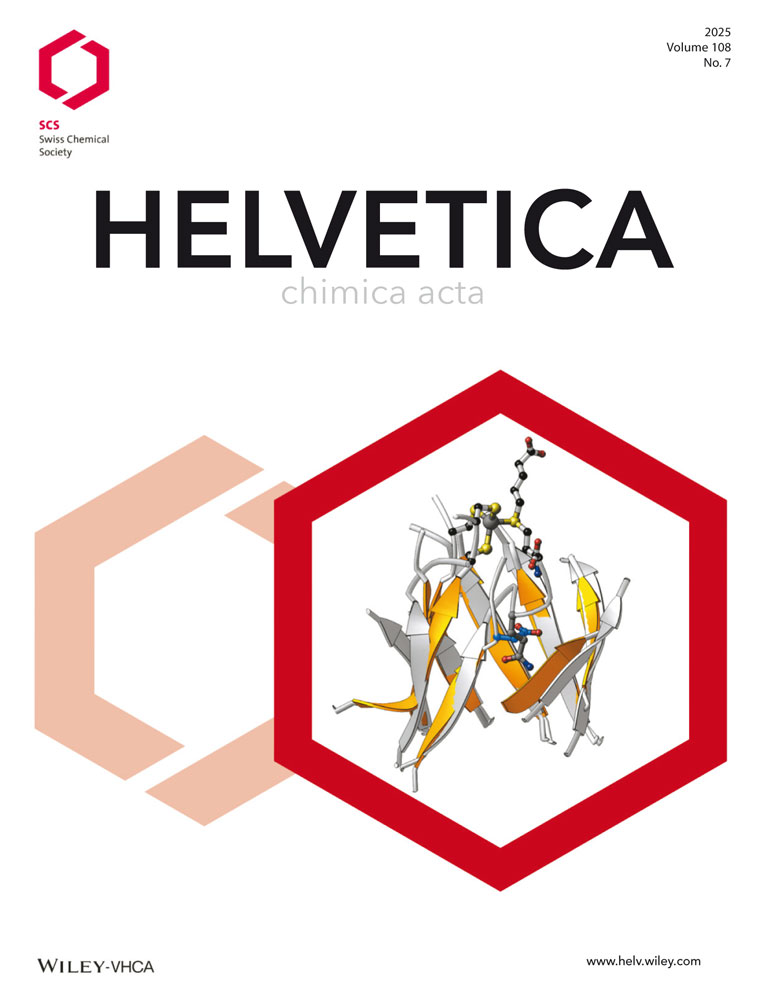Benzo[a]heptalenes from Heptaleno[1,2-c]furans. Part I
Cycloaddition Reaction of Heptaleno[1,2-c]furans with Different Dienophiles
Abstract
It is shown that heptaleno[1,2-c]furans 1, which are available in two steps from heptalene-4,5-dicarboxylates by reduction and oxidative dehydrogenation of the corresponding vicinal dimethanols 2 with MnO2 or IBX (Scheme 4), react thermally in a Diels–Alder-type [4+2] cycloaddition at the furan ring with a number of electron-deficient dipolarophiles to yield the corresponding 1,4-epoxybenzo[d]heptalenes (cf. Schemes 6, 15, 17, and 19). The thermal reaction between dimethyl acetylenedicarboxylate (ADM) and 1 leads, kinetically controlled, via a sterically less-congested transition state (Fig. 4) to the formation of the (M*)-configured 1,4-dihydro-1,4-epoxybenzo[a]heptalenes, which undergo a cyclic double-bond shift to the energetically more-relaxed benzo[d]heptalenes 4 (Schemes 6 and 7). Most of the latter ones exhibit under thermal conditions epimerization at the axis of chirality, so that the (M*)- and (P*)-stereoisomers are found in reaction mixtures. The (P*)-configured forms of 4 are favored in thermal equilibration experiments, in agreement with AM1 calculations (Table 1). The relative (P*,1S*,4R*)- and (M*,1S*,4R*)-configuration of the crystalline main stereoisomers of the benzo[d]heptalene-2,3-dicarboxylates 4a and 4f, respectively, was unequivocally established by an X-ray crystal-structure determination (Figs. 1 and 2). Acid-induced rearrangement of 4 led to the formation of the corresponding 4-hydroxybenzo[a]heptalene-2,3-dicarboxylates 5 in moderate-to-good yields (Schemes 8, 13, and 14). When the aromatization reaction is performed in the presence of trifluoroacetic acid (TFA), trifluoroacetates of type 6 and 13 (Schemes 8, 12, and 13) are also formed via deprotonation of the intermediate tropylium ions of type 7 (Scheme 11). Thermal reaction of 1 with dimethyl maleate gave the 2,3-exo- and 2,3-endo-configured dicarboxylates 14 as mixtures of their (P*)- and (M*)-epimers (Scheme 15). Treatment of these forms with lithium di(isopropyl)amide (LDA) at −70° gave the expected benzo[a]heptalene-2,3-dicarboxylates 15 in good yields (Scheme 16). Fumaronitrile reacted thermally also with 1 to the corresponding 2-exo,3-endo- and 2-endo,3-exo-configured adducts 17, again as mixtures of their (P*)- and (M*)-epimers (Scheme 17), which smoothly rearranged on heating in dimethoxyethane (DME) in the presence of Cs2CO3 to the benzo[a]heptalene-2,3-dicarbonitriles 18 (Scheme 18). Some cursory experiments demonstrated that hex-3-yne-2,5-dione and (E)/(Z)-hexa-3-ene-2,5-dione undergo also the Diels–Alder-type cycloaddition reaction with 1 (Scheme 19). The mixtures of the stereoisomers of the 2,3-diacetyl-1,4-epoxytetrahydrobenzo[d]heptalenes 22 gave, on treatment with Cs2CO3 in DME at 80°, only mixtures of the regioisomeric inner aldol products 24 and 25 of the intermediately formed benzo[a]heptalenes 23 (Scheme 20).




